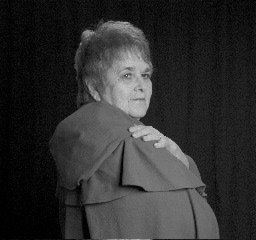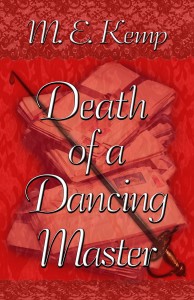 Relevant History welcomes back best-selling historical mystery author Edith Maxwell, a 2017 double Agatha Award nominee for her historical mystery Delivering the Truth and her short story, “The Mayor and the Midwife.” She writes the Quaker Midwife Mysteries and the Local Foods Mysteries; as Maddie Day she writes the Country Store Mysteries and the Cozy Capers Book Group Mysteries. Her award-winning short crime fiction has appeared in many juried anthologies, and she is honored to serve as President of Sisters in Crime New England. A former doula, Maxwell lives north of Boston with her beau and three cats. For more information about her and her books, visit her web site and group blog, and follow her on Facebook, Twitter, Pinterest, and Instagram.
Relevant History welcomes back best-selling historical mystery author Edith Maxwell, a 2017 double Agatha Award nominee for her historical mystery Delivering the Truth and her short story, “The Mayor and the Midwife.” She writes the Quaker Midwife Mysteries and the Local Foods Mysteries; as Maddie Day she writes the Country Store Mysteries and the Cozy Capers Book Group Mysteries. Her award-winning short crime fiction has appeared in many juried anthologies, and she is honored to serve as President of Sisters in Crime New England. A former doula, Maxwell lives north of Boston with her beau and three cats. For more information about her and her books, visit her web site and group blog, and follow her on Facebook, Twitter, Pinterest, and Instagram.
*****
[Note: A version of this post first appeared on Storybook Reviews.]
My Quaker Midwife Mysteries take place in a bustling New England mill and carriage factory town in the late 1880s–which happens to be the town I live in. The family my midwife Rose Carroll lives with resides in my house, or the way my house was when it was brand-new and built for workers who toiled in the textile mill a block down the hill. By now it has had two additions to the back, but the heart of the home remains.
 We bought this house five years ago, and my boyfriend has renovated the entire structure, right down to the studs. We now have new plumbing, new wiring, insulation, smooth walls and ceilings, but we kept the original wide pine floors and the window and door trim. We’ve tried to keep the additions reminiscent of the period when the house was built, so the kitchen has old-timey looking subway tiles for backsplash, as does the bathroom.
We bought this house five years ago, and my boyfriend has renovated the entire structure, right down to the studs. We now have new plumbing, new wiring, insulation, smooth walls and ceilings, but we kept the original wide pine floors and the window and door trim. We’ve tried to keep the additions reminiscent of the period when the house was built, so the kitchen has old-timey looking subway tiles for backsplash, as does the bathroom.
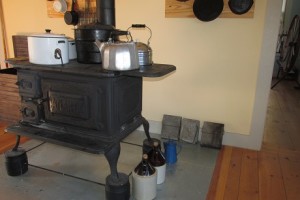 We opened up the kitchen to the sitting room, and I love to perch on the couch and gaze into the kitchen, imagining Rose and her teenage niece Faith cooking and cleaning for the family. But what would it have looked like back then? This is a modest three-bedroom house, not a big fancy Victorian with maid’s quarters and a deluxe dining room.
We opened up the kitchen to the sitting room, and I love to perch on the couch and gaze into the kitchen, imagining Rose and her teenage niece Faith cooking and cleaning for the family. But what would it have looked like back then? This is a modest three-bedroom house, not a big fancy Victorian with maid’s quarters and a deluxe dining room.
I have visited several museum homes of the period. One was Orchard House, where the Alcott family lived. It’s only an hour from my home. I also stayed at a living history farmhouse in Maine where the public is invited for 24-hour live-in experiences. The Norlands-Washburn center features late nineteen-century life, from the wood cookstove to the chamberpot under the bed! And I often peruse Miss Parloa’s New Cook Book and Marketing Guide, where she speaks extensively of what a “hygienic” kitchen needs.
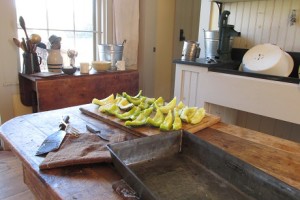 Rose’s kitchen would have had a wide soapstone sink and running water from a pump. The wide wooden table would have been used for food preparation as well as eating meals, and the cabinet space would have been limited. They might have had gas lighting on the walls, but not yet a gas stove. Certain places in town were starting to be electrified, but definitely not Rose’s home. Refrigeration would have been an icebox. The door to the outside was fitted with a screen door, a new invention that did wonders for keeping the bugs out but letting a breeze circulate in a hot July when Called to Justice takes place.
Rose’s kitchen would have had a wide soapstone sink and running water from a pump. The wide wooden table would have been used for food preparation as well as eating meals, and the cabinet space would have been limited. They might have had gas lighting on the walls, but not yet a gas stove. Certain places in town were starting to be electrified, but definitely not Rose’s home. Refrigeration would have been an icebox. The door to the outside was fitted with a screen door, a new invention that did wonders for keeping the bugs out but letting a breeze circulate in a hot July when Called to Justice takes place.
The family did hire out the washing, and by Book Three in the series (Turning the Tide, 2018) Rose has convinced her widower brother-in-law to hire a kitchen girl, too. Rose has a busy midwifery practice, and Faith works full time in the Hamilton Mills, and Rose argued that it wasn’t fair to either of them to have to do all the housework, too.
I also often think of the Laura Ingalls Wilder series, which I read several times as a child. Those stories take place primarily on the prairie and the frontier, certainly, but many of the everyday household tasks would have been the same.
Readers: Do you have any fabulous late Victorian research sources? Knowledge of everyday life from back then? Please share!
*****
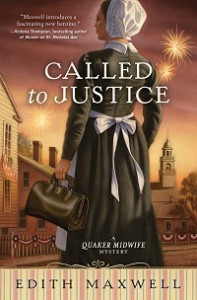 A big thanks to Edith Maxwell. She’ll give away a paperback copy of her Fourth of July mystery, Called to Justice, to someone who contributes a comment on my blog this week. (Here’s a good review of the book.) I’ll choose the winner from among those who comment by Friday at 6 p.m. ET. Delivery is available worldwide.
A big thanks to Edith Maxwell. She’ll give away a paperback copy of her Fourth of July mystery, Called to Justice, to someone who contributes a comment on my blog this week. (Here’s a good review of the book.) I’ll choose the winner from among those who comment by Friday at 6 p.m. ET. Delivery is available worldwide.
**********
Did you like what you read? Learn about downloads, discounts, and special offers from Relevant History authors and Suzanne Adair. Subscribe to Suzanne’s free newsletter.

